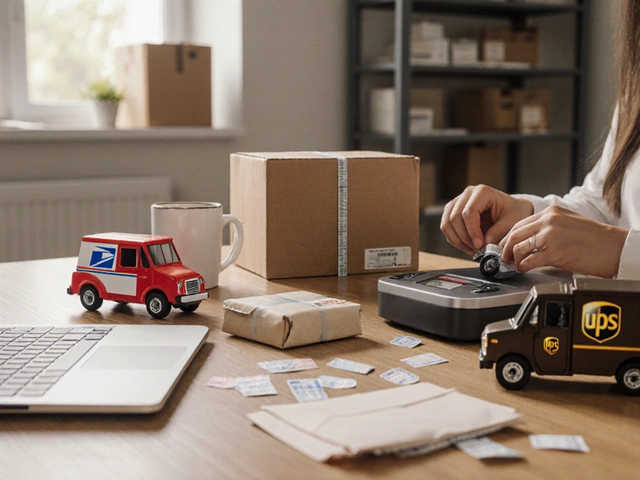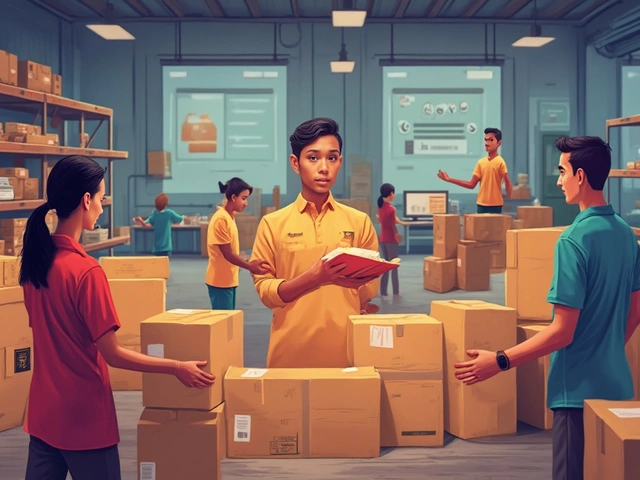If you’ve ever tracked a package that seemed to zigzag across town before finally landing at your door, you’ve seen last mile delivery chaos in action. This “last mile” isn’t measured by distance—it's the final stretch from the local hub to the actual customer, and it’s packed with surprises. Traffic jams, confusing addresses, missing doorbells—stuff you just can’t script.
But here’s where things get interesting. Getting the last mile right can seriously boost your customer ratings and even save you cash in the long run. Want to stop playing delivery roulette? Start by looking at where your process trips up—like drivers taking the longest way or packages ending up at the wrong house. Once you know your hiccups, you can handle last mile delivery like a champ.
- Why Last Mile Delivery Gets Messy
- Nailing the Route: Smarter Planning
- Tech That Makes It Easier
- Dealing with Delays and Delivery Fails
- Winning on the Customer Front
Why Last Mile Delivery Gets Messy
Last mile delivery is where most headaches happen. You’re not dealing with big trucks on highways anymore. It’s a whole different game—side streets, locked gates, and customers who aren’t even home. It eats up a shocking amount of delivery costs too. According to Business Insider, the last mile often makes up more than 50% of the total shipping expense. That’s right: half your cost is just getting the package from a local depot to someone's door.
Let’s break down the top reasons it gets so tangled:
- last mile delivery faces real unpredictability—traffic, weather, even dogs guarding the porch.
- Addresses aren’t always clear, especially in new neighborhoods or apartment complexes.
- Customer expectations are through the roof. Most people want real-time updates, narrow delivery windows, and maybe even a photo to prove it made it.
- Failed first delivery attempts are common. No one likes coming back, but sometimes there’s just no other way.
Take a look at why these issues matter so much for your costs and time:
| Challenge | Impact |
|---|---|
| Traffic Jams | Late deliveries, extra fuel costs |
| Failed Deliveries | Return trips, wasted driver hours |
| Poor Address Data | Lost packages, angry customers |
| High Expectations | Pressure for perfect tracking, more support calls |
This all adds up fast. One failed delivery attempt can cost as much as $15 in some cities, when you count the return, the rescheduling, and unhappy customers calling in. No wonder businesses are scrambling to find smarter ways to handle these bumps. Ignoring them? That’s just money slipping through your fingers.
Nailing the Route: Smarter Planning
If you think a delivery driver just hops in the van and wings it, think again. Route planning is all about working smarter, not harder. About 53% of total delivery costs happen during the last mile delivery stage, mostly because of things like traffic, bad addresses, or drivers just taking the scenic route without meaning to.
Smart companies use route optimization tools that spit out the most efficient stops, save on fuel, and shave hours off delivery times. Google Maps does a decent job if you’re tiny, but bigger operations lean on software like Routific or Onfleet. The cool part? These tools factor in live traffic, package sizes, delivery windows, and can even reshuffle stops on the fly if something goes sideways.
Here are some practical tips if you want routes that actually work:
- Always double-check addresses before leaving the hub—mistyped house numbers are a top reason for failed deliveries.
- Group deliveries by zip code or neighborhood to cut down on drive time.
- Set realistic delivery windows and share them with customers to avoid missed drop-offs.
- Use apps with “proof of delivery” photos—saves headaches when someone claims their package disappeared.
Take a look at the impact route optimization can have on your delivery gig:
| Scenario | Avg. Deliveries per Day | Fuel Used (Liters) | Driver Hours |
|---|---|---|---|
| No Route Planning | 60 | 35 | 9 |
| With Route Optimization | 75 | 28 | 7 |
Numbers don’t lie. Better routing means more deliveries, less fuel burned, and happier drivers. If you want to save both money and sanity, even a small tweak in how you plan your routes can make a massive difference.

Tech That Makes It Easier
Juggling dozens of home deliveries isn’t just about having a good van and an early start. Tech has totally changed the game for last mile delivery, and if you’re not using it, you’re playing catch-up. The right tools can cut routes in half, keep customers in the loop, and make life way smoother for drivers.
The biggest upgrade in recent years? Route optimization software. Stuff like Circuit, Routific, and Onfleet automatically figure out the fastest path for drivers—even if they’re juggling a mountain of stops. Instead of guessing which street has less traffic, drivers get real-time directions that actually react to things like road closures or accidents. According to Onfleet, some companies have slashed driving times by 30% after adding smart routing into their daily grind.
Another winner is real-time package tracking. Customers now expect to see where their parcel is, minute by minute. Sending live tracking links can cut down on “Where’s my order?” calls by over 40%, based on data shared by FarEye. And it gives drivers a break from last-minute address checks.
Proof of delivery tech also helps a ton. Mobile apps let drivers snap a quick photo, grab a signature, or log a GPS tag—no more arguments over who actually got the package. A lot of insurers even look for this kind of backup before they’ll pay out for lost stuff.
- Apps for drivers: Most companies now use mobile apps that scan barcodes, auto-update delivery statuses, and ping dispatch in case something goes sideways.
- Automated customer alerts: Software sends texts or emails when packages are out for delivery or left at the door.
- Fleet management systems: These track where vehicles are in real time and spot bottlenecks.
| Tech Feature | Estimated Time Savings |
|---|---|
| Route Optimization | 20%-30% |
| Live Customer Tracking | 40% fewer support calls |
| Proof of Delivery Apps | Reduces disputes by 80% |
Bottom line: layering in the right tech isn’t just about looking fancy—it’s about cutting mistakes, saving time, and keeping the customer happy. No more old-school guesswork or grumpy “where’s my box?” calls. If you’re not on board, you’re already behind.
Dealing with Delays and Delivery Fails
Let’s be real—delays are a headache no matter how slick your delivery game is. The biggest reasons for delays in last mile delivery are traffic jams, wrong addresses, and “customer not home” situations. According to a 2024 study by Zebra Technologies, 55% of logistics businesses listed urban traffic and parking as their top delivery hurdles. Bad weather and tight time windows bump the fail rate even higher.
Rescheduling missed deliveries eats up more time and money than most people think. Every failed first attempt actually costs up to $17 per package on average, based on data from Bringg (2023). Ouch. The longer a package sits in a van, the more it chips away at your profit.
| Common Delay Cause | Percent of Deliveries Affected |
|---|---|
| Traffic or Parking | 28% |
| Wrong Address | 13% |
| Customer Not Home | 19% |
| Weather Issues | 11% |
| Other | 29% |
So what do you actually do when delays bite? Here’s what works for most delivery teams:
- Keep customers in the loop: Automated text updates go a long way. If there’s a holdup, text or email them ASAP. This drops "where’s my package?" calls fast.
- Give delivery time windows: A tight two-hour window beats a vague "sometime today." People love knowing when to expect you, and are likelier to be home.
- Double-check addresses: Ask for photos or special notes if a location is tricky, or build in a quick address check before leaving the hub. A wrong address wastes hours.
- Prep for Plan B: When you can’t deliver, have an easy way for customers to reschedule or pick up at a local spot. This wins back unhappy customers.
If you’re running a fleet, review your missed deliveries every week. Spot the patterns. Maybe a certain zip code is always trouble, or one driver has more fails—then you can get right to the real issue instead of guessing.

Winning on the Customer Front
Nailing last mile delivery means making the customer happy, plain and simple. People don’t care how hard your day was; they just want their stuff, where and when you promised. Here’s where the little things make or break you—nobody raves about a package that arrived late and soggy, but everyone remembers when you knocked it out of the park.
Real-time tracking is no longer just a bonus. According to a 2024 Statista survey, 88% of online shoppers said they expect to know exactly where their order is at any moment. If your system doesn’t keep up, customers will choose someone who does. Send updates for every step—"Out for Delivery" or "Arriving in 15 Minutes"—and make those alerts clear and easy to follow.
Let’s not ignore flexibility. More than half of customers reschedule deliveries because they’re not home during typical hours. Offer options like evening drop-offs or the ability to change delivery slots at the last minute. Adding those pickup lockers at grocery stores or malls isn’t just trendy; it’s actually cut down missed deliveries by up to 30% in some cities.
Customer support is huge. If something goes wrong, nobody wants to wait on hold. An easy-to-find help button in your app or a chatbot with instant answers goes a long way. Quick resolutions and simple refund or redelivery options keep frustration low and win you return business.
Here’s a look at what matters most to customers during that crucial last mile switchover:
| Customer Expectation | Percent Who Value This (2024) |
|---|---|
| Real-time tracking | 88% |
| Flexible scheduling | 57% |
| Friendly delivery drivers | 74% |
| Clear communication/notifications | 83% |
| Easy help access | 69% |
Want to stand out? Train your drivers to be polite and deliver with a smile. It’s not rocket science, but good vibes really do matter. Encourage snapping a photo as proof of delivery and make it easy for customers to give quick feedback. Every one of these things stacks up to a better last mile delivery experience, which keeps people coming back instead of checking out your competitor’s website.





